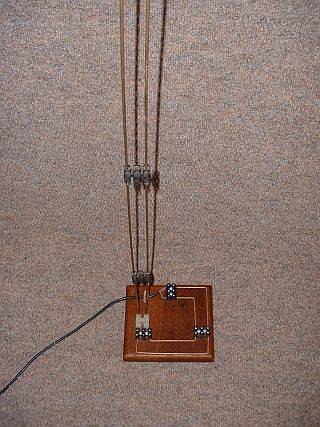Many radio amateurs are faced with the problem of being unable to erect any type of 2 meter outdoor antenna. This means the only viable alternative is an indoor antenna. The simple antenna described in this article is easy to construct and needs little by way of materials. These amount to brazing rods (or wire coat-hangers), two strips of 30A “chock-block” screw type connectors, a few wood screws and a piece of wood for a base. No soldering is required except for a plug on the transmitter end of the coax cable. It takes very little time to construct and, aside from its application as a permanent indoor antenna, it could be taken away on holiday or to the hospital and used for portable operation. The antenna arrangement is based on the popular “Slim Jim” design, designed some years ago by F.C. Judd G2BCX. The method of construction and other modifications have not only allowed a significant reduction in size, but also provide a broader bandwidth, the SWR being virtually 1:1 right across the 2 meter band.
CONSTRUCTION:
The major part of construction is the matching line, which is fixed to the base board as shown in Fig 1. The illustration shows the positions of the three electrical connector blocks which carry the matching line wires. One of these connector blocks also provides a support and connecting point for the vertical radiating element, which is fitted at the points marked “X”. However, before screwing down the connector blocks, cut from one of the lengths of brazing rod the sections that will form the matching line as given in Fig. 2. These are connected, as in Fig. 1, to form a continuous pair of lines between the coaxial cable and the bottom of the radiating element. The positions of the blocks may require shifting slightly to obtain a symmetrical layout. After this has been achieved they may be screwed into place. Next the radiating element, details for which are given in Fig. 3. The two long wires are cut to the dimensions given, and then the electrical connector blocks are fitted. These give the vertical element wires the correct spacing, as well as support and their positioning is not critical. The very top section of the radiator is a separate “U” shaped piece of brazing rod. (No 5 shown in Fig. 3) This part is slotted into the top connector block, and consequently will provide a small variation in radiator length. With this method of adjustment, the antenna can be made to resonate, allowing minimum SWR to be obtained.
TUNING AND SWR:
First, a few words about the coaxial cable which must be 50 Ohm. Low-loss cable would be preferred if the cable run is more than 6 meters long. The lower the cable attenuation, the more r.f. power there will be available for radiation by the antenna. Remember, for indoor operation every little bit counts, especially when it is realized that brick walls and tiled roofs may offer as much as 10 dB attenuation, even when dry. Final adjustment should be carried out at mid-band with a SWR meter in line at the transmitter end. Stand the antenna on a table and make a quick check on SWR. It may be a little too high, in which case adjust the top section of the radiator up or down until he SWR is brought to within respectable limits. Stand back from the antenna after each adjustment as “body capacity” can affect tuning. Some experimentation may be necessary to find the best SWR reading.
FINALLY:
Why the name: A “Hospital” Slim Jim?
I constructed this antenna in August 2004 for a fellow radio amateur who visited a Mossel Bay hospital quite regularly. He wanted to talk to fellow radio amateurs in the Southern Cape area
while in hospital but was unable to activate the local repeater with his
HT using a rubber duck antenna. I decided to assist him by building
this antenna and named it the "Hospital" Slim Jim Antenna.
Tests carried out under hospital conditions showed that reliable contacts with stations using outside antennas could be made over distances of 16km.
REFERENCES
THE SLIM JIM 2 METER ANTENNA F.C. JUDD
PRACTICAL WIRELESS AUGUST 1988
MULTI-WIRE DIPOLE ANTENNAS. J.D. KRAUS
Images: (Click on images for larger view.)









